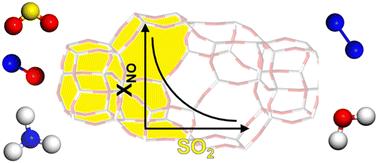SO2对Cu-CHA催化剂NH3-SCR†活性影响的定量分析
IF 4.2
3区 化学
Q2 CHEMISTRY, PHYSICAL
引用次数: 0
摘要
在低于300℃的温度下,用于氨(NH3-SCR)选择性催化还原柴油尾气中NOx的Cu-CHA催化剂在SO2存在下失活。在本文中,我们开发了一个描述性模型来评估催化剂失活方面的SO2耐受性,在活性催化剂的消失。这就导致了SO2的敏感性,这可以解释为每mol SO2被催化剂吸收的催化剂损失,作为催化剂材料失活的衡量标准。我们确定了三种Cu- cha催化剂的SO2敏感性,即Si/Al比为6.7的1.6 wt% Cu和3.2 wt% Cu和Si/Al比为15的3.2 wt% Cu。与其他两种催化剂相比,3.2 wt% Cu (Si/Al = 6.7)催化剂在200°C时表现出较低的SO2敏感性。三种催化剂对二氧化硫的敏感性在低二氧化硫吸收量时最高,随二氧化硫吸收量的增加而线性降低。这意味着少量的SO2会导致相对强烈的失活,表明失活是SO2与活性Cu反应的结果。本文章由计算机程序翻译,如有差异,请以英文原文为准。

A quantitative analysis of the impact of SO2 on the activity of Cu-CHA catalysts for NH3-SCR†
Copper-exchanged chabazite (Cu-CHA) catalysts for selective catalytic reduction of NOx by ammonia (NH3-SCR) in diesel exhausts deactivate in the presence of SO2 at temperatures below 300 °C. In this article, we develop a descriptive model to evaluate a catalyst deactivation with respect to SO2 tolerance, in terms of a disappearance of active catalyst. This leads to the SO2 sensitivity, which can be interpreted as the loss of catalyst per mol SO2 taken up by the catalyst, as a measure for the deactivation for that catalyst material. We have determined the SO2 sensitivity for three Cu-CHA catalysts, namely 1.6 and 3.2 wt% Cu with a Si/Al ratio of 6.7 and 3.2 wt% Cu with a Si/Al ratio of 15. The 3.2 wt% Cu (Si/Al = 6.7) catalyst shows a lower SO2 sensitivity at 200 °C, as compared to the other two catalysts. For all three catalysts, the SO2 sensitivity is highest at low SO2 uptake, and decreases linearly with the further uptake of SO2. This means that small amounts of SO2 cause a relatively strong deactivation, indicating that the deactivation is a consequence of a reaction of SO2 with the active Cu.
求助全文
通过发布文献求助,成功后即可免费获取论文全文。
去求助
来源期刊

Catalysis Science & Technology
CHEMISTRY, PHYSICAL-
CiteScore
8.70
自引率
6.00%
发文量
587
审稿时长
1.5 months
期刊介绍:
A multidisciplinary journal focusing on cutting edge research across all fundamental science and technological aspects of catalysis.
Editor-in-chief: Bert Weckhuysen
Impact factor: 5.0
Time to first decision (peer reviewed only): 31 days
 求助内容:
求助内容: 应助结果提醒方式:
应助结果提醒方式:


